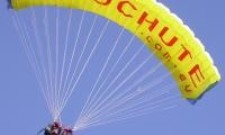Nov 4 2013
Swinburne University of Technology is entering the flying electric vehicle research space with work about to begin on building a dual seater electric powered parachute.

Swinburne will work with Melbourne based company Aerochute International Pty Ltd to develop and manufacture the dual seater Skymaster Pro after securing a Victorian government grant.
The funding will be used to build and develop the dual seater electric powered parachute, which has been designed by a team of six final year Robotics and Mechatronics and Product Design Engineering students - Daniel Espiritu, Damien Chiem, Uriel Navarro, Alex Wocadlo, Clint Waters and Robin Smiley - under the supervision of Swinburne's Senior Lecturer, Product Design Engineering, Dr Clint Steele and Aerochute International's Rex Lee and the company's CEO Stephen Conte.
"The funding means we can now take the concept that we have developed, build it and test it," Dr Steele said.
"In the process Swinburne will be helping a small high-tech Australian company to progress into the area of flying electric powered vehicles."
Aerochute International, which has been producing and flying powered parachutes for more than 23 years, is the market leader in powered parachutes in Australia and has an excellent safety record.
Mr Conte said Aerochute International has been working on electric powered parachutes for some time and could see the benefits of teaming with Swinburne.
"We are excited to be working with the students at Swinburne as they bring design knowledge, electric vehicle skills and enthusiasm to the project which will ultimately result in a better electric powered parachute," Mr Conte said.
The Skymaster Pro will weigh approximately 130 kilograms and be able to take a payload of up to 190 kilograms. It will be capable of reaching speeds of up to 60kph and will have a flight time of one hour before the batteries need recharging. The dual seater electric powered parachute will be able to climb to a maximum of 5000ft at a climbing rate of 350ft per minute.
It will have counter-rotating propellers powered by four 16kw motors, which will run off lithium polymer batteries.
The Skymaster Pro has been designed also with safety in mind. Unlike some current petrol powered models on the market, it includes a fully enclosed roll cage, feet protection and the batteries will have circuit breakers to prevent a fire in the advent of an overload or short circuit.
Dr Steele said there were advantages for commercial operators who decided to use an electric powered parachute.
"Maintenance will be much easier than on a petrol model as there is no need for an oil change, no oil filter and it won't need a tune up," Dr Steele said.
"For commercial operators they will be able to swap the battery packs quickly rather than having to wait for them to be recharged."
A prototype of the Skymaster Pro is expected to be finished early next year and will then undergo rigorous testing by Aerochute International.
Those wanting to fly a powered parachute need to have a Recreation Aviation Australia (RAA) group D power parachute licence.